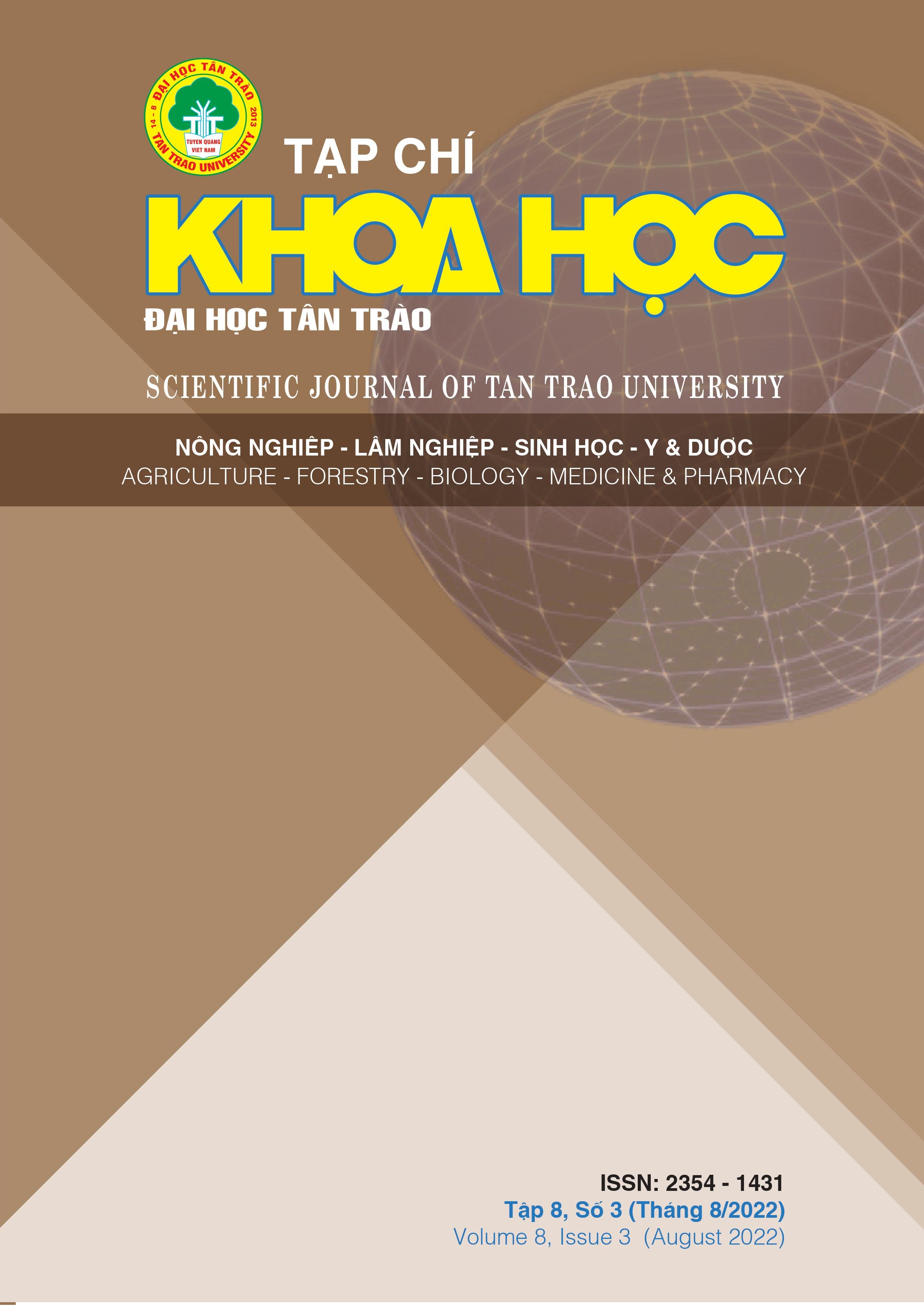CANKER DISEASE CAUSING BY Fusarium proliferatum ON Dendrobium anosmum IN THAI NGUYEN, VIETNAM
DOI:
https://doi.org/10.51453/2354-1431/2022/790Keywords:
Canker disease, Dendrobium anosmum, Fusarium proliferatum, OrchidAbstract
Orchid growing activities are popular in Vietnam, especially Dendrobium anosmum. In Thai Nguyen, orchid gardens often have canker disease on D. anosmum plants. In this study, fungal composition belonging Fusarium genus was isolated from diseased leaf and root by baiting method. Typical symptoms are sores on the stem, leaves turn yellow, wilt, dry and die. The morphology, taxonomy and pathogenicity of the pathogens causing canker disease were investigated in orchids in Thai Nguyen city, Vietnam. From ITS1 and ITS4 sequence analysis, Fusarium proliferatum was identified as the pathogen causing canker disease in D. anosmum. This species was pathogenic in inoculation trials using seedlings. They cause canker diseases commonly in Thai Nguyên city, so further research is needed to manage the disease.
Downloads
References
[1]. Abdullah, H. I. R. Y. A. T. I., & Kadzimin, S. A. L. E. H. (1993). Etiology of bacterial soft rot of orchids. Pertanika Journal of Tropical Agricultural Science, 16:1-4.
[2]. Averyanov, L. V., Loc, P. K., Hiep, N. T., & Harder, D. K. (2003). Phytogeographic review of Vietnam and adjacent areas of Eastern Indochina. Komarovia, 3, 1-83.
[3]. Averyanov, L. V., Nguyen, K. S., Maisak, T. V., & Truong, B. V. (2019). New orchids (Orchidaceae) in the flora of Vietnam I. Epidendroideae. Taiwania, 64(2).
[4]. Nguyen Minh Chi (2021). Rot Disease in Aerides falcata and A. odorata Caused by Pantoea ananatis in Hoa Binh Province, Viet Nam. Journal of Plant Protection, 1: 15-21
[5]. Nguyen Minh Chi, Pham Quang Thu, Lam Van Phong, Ngo Dinh Van, Nguyen Van Nam and Nguyen Thi Tuyen (2019). Root rot disease caused by Fusarium proliferatum on citrus in Quang Ninh province, Vietnam. Vietnam Journal of Agriculture and Rural Development, 19: 44-49.
[6]. De, L. C., Chhetri, G., & Medhi, R. P. (2013). Orchids - a wonderful crop for diversification. J. Orchid Soc. India, 27(1-2), 1-8.
[7]. Bui Thi Duyen, Nguyen Van Tuat (2012). Study on major diseases of boat Orchids (Cymbidium sp.) and recommendation of control measures in Sa Pa, Lao Cai province. Vietnam Journal of Agriculture and Rural Development, 18:33-39.
[8]. Tran Thi Thu Ha, Nguyen Van Duc Tien, Tran Thanh Duyen (2011). The result of the survey on the main pests of orchids in Ho Chi Minh City. Journal of Plant Protection, 4:25-30.
[9]. Hall, T. A. (1999). BioEdit: a user-friendly biological sequence alignment editor and analysis program for Windows 95/98/NT. In Nucleic acids symposium series, 41, 95-98.
[10]. Hyun, J. W., Lee, S. C., Kim, D. H., Ko, S. W., & Kim, K. S. (2000). Fusarium fruit rot of citrus in Jeju Island. Mycobiology, 28(3), 158-162.
[11]. Keith, L. M., Sewake, K. T., & Zee, F. T. (2005). Isolation and characterization of Burkholderia gladioli from orchids in Hawaii. Plant disease, 89(12), 1273-1278.
[12]. Khoiri, S., Damayanti, T. A., & Giyanto, G. (2016). Identification of quorum quenching bacteria and its biocontrol potential against soft rot disease bacteria, Dickeya dadantii. Journal of Agricultural Science, 39(1), 45-55.
[13]. Lee, D. H., Kim, J. H., Lee, J. H., Hur, J. S., & Koh, Y. J. (1999). Bacterial soft rot of Dendrobium phalaneopsis and Phalaneopsis species by Erwinia chrysanthemi. The Plant Pathology Journal, 15(5), 302-307.
[14]. Lu, H., Lan, S., Tsai, W., Liu, Z. (2019). The origin and evolution of orchids. Journal of Fujian Agriculture and Forest University, 6:689-694.
[15]. O’Gara, E., Colquhoun, I.J., McComb, J.A. and Hardy, G.E.St.J., 1997. The infection of non-wounded and wounded periderm tissue at the lower stem of Eucalyptus marginata by zoospores of Phytophthora cinnamomi, in a rehabilitated bauxite mine, Australasian Plant Pathology, (26), pp. 135-141.
[16]. Pham, Q. M., Duong, K. C., Quach, P. N. D., & Hoang, M. T. T. (2018). Micropropagation and nursery at the garden of Dendrobium caesar. Science and Technology Development Journal-Natural Sciences, 2(3), 14-22.
[17]. Takahashi, Y., Takahashi, K., Sato, M., Watanabe, K., & Kawano, T. (1997). Bacterial leaf rot of Odontioda orchids caused by Enterobacter cloacae. Japanese Journal of Phytopathology, 63(3), 164-169.
[18]. Nguyen Kim Van (2005). Survey on diseases of Orchards, Rose and Chrysanthemy in Hanoi region in 2005. Journal of Plant Protection, 24:25-30.
[19]. Yaseen, T., & D'Onghia, A. M. (2010). Fusarium spp. associated to citrus dry root rot: An emerging issue for Mediterranean citriculture. In XXVIII International Horticultural Congress on Science and Horticulture for People (IHC2010): International Symposium on the 940 (pp. 647-655).
Downloads
Published
How to Cite
Issue
Section
License

This work is licensed under a Creative Commons Attribution-ShareAlike 4.0 International License.
All articles published in SJTTU are licensed under a Creative Commons Attribution-ShareAlike 4.0 International (CC BY-SA) license. This means anyone is free to copy, transform, or redistribute articles for any lawful purpose in any medium, provided they give appropriate attribution to the original author(s) and SJTTU, link to the license, indicate if changes were made, and redistribute any derivative work under the same license.
Copyright on articles is retained by the respective author(s), without restrictions. A non-exclusive license is granted to SJTTU to publish the article and identify itself as its original publisher, along with the commercial right to include the article in a hardcopy issue for sale to libraries and individuals.
Although the conditions of the CC BY-SA license don't apply to authors (as the copyright holder of your article, you have no restrictions on your rights), by submitting to SJTTU, authors recognize the rights of readers, and must grant any third party the right to use their article to the extent provided by the license.


